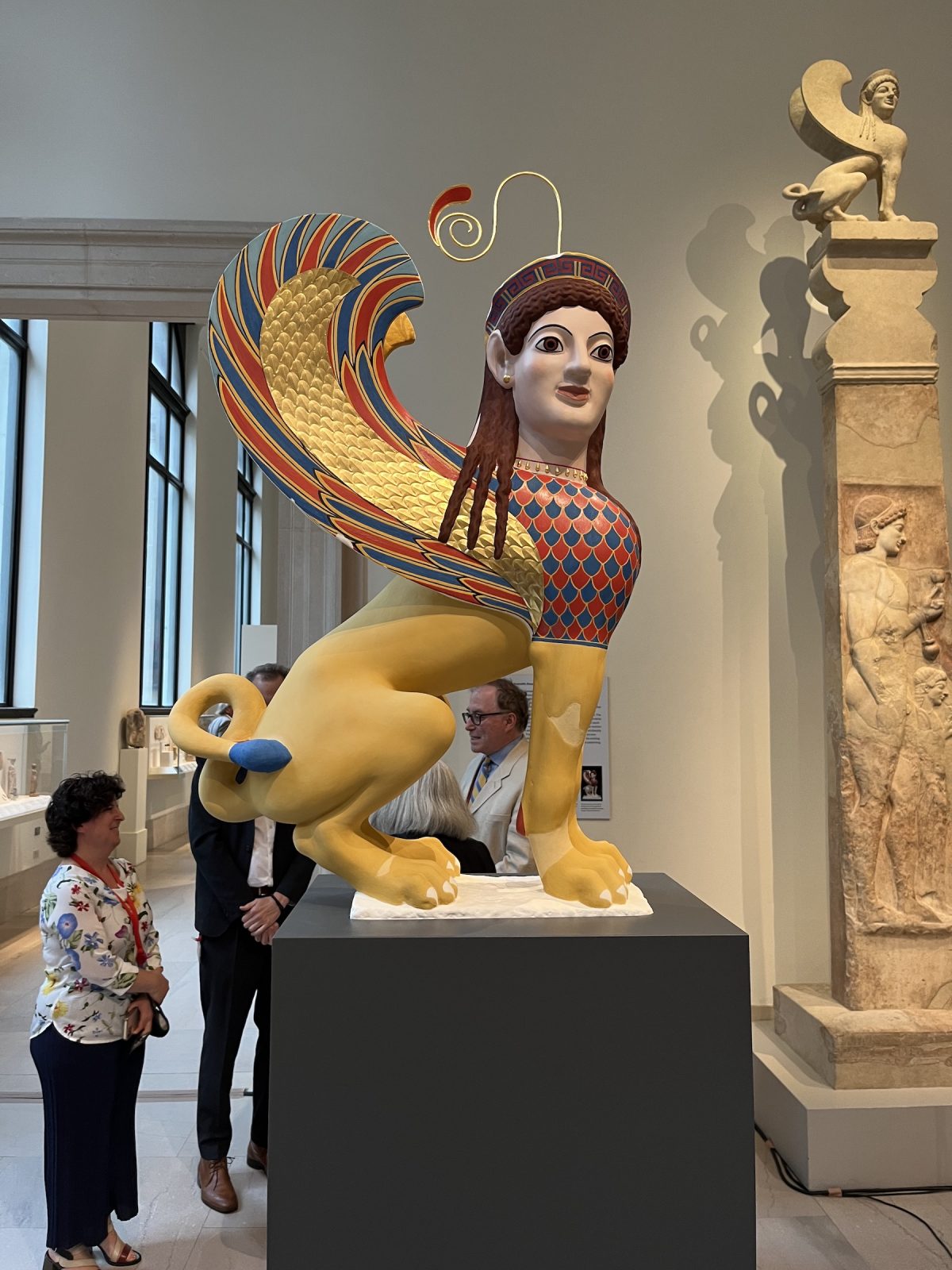Met Exhibition Brings Back the Color to Ancient Sculptures
4 min read [ad_1]
In Ancient Greece in 530 BCE, site visitors to the grave of a young boy and lady would have gazed towards the sky and seen a brightly painted sphinx perched atop the 13-foot marble stele that marked the children’s ultimate resting position.
The stele and sphinx, on show as portion of the selection of the Metropolitan Museum of Artwork, seem just like the other sculptures in the museum’s sunlight-lit halls — a stark white. But a new exhibition, Chroma: Ancient Sculpture in Color, showcases the sphinx in its unique lively form, a person of 14 painted reconstructions of Historic Greek and Roman statues. On view through March 23 of 2023, Chroma also highlights 40 other objects that contextualize polychromy, the portray of historic sculpture and pottery.

Chroma is the end result of an comprehensive collaboration between conservators, experts, and curators who aided to create the reproduction of the sphinx. The exhibition’s other reconstructions have been produced by Vinzenz Brinkmann, head of antiquities at the Liebieghaus Skulpturensammlung in Frankfurt, and Ulrike Koch-Brinkmann. The husband-and-wife team has researched polychromy for more than 40 years. Their Gods in Coloration exhibition has been touring since 2003, and their replicas have been incorporated in museums all over the environment.
Instead of relegating the vibrant reconstructions to a separate gallery house, the will work at the Achieved are interspersed within just the museum’s iconic ancient sculpture halls, with a small upstairs gallery devoted completely to the clearly show. All over the exhibition, labels explain the scientific system for identifying the statues’ true colors.
Sarah Lepinski, associate curator in the Met’s Division of Greek and Roman Art, preferred the functions to be in dialogue with the museum’s selection. When achievable, the replicas are displayed close to similar operates (the originals are dispersed in collections through the planet). But in the circumstance of the sphinx, the replica stands adjacent to the serious factor.
“We considered this would get the job done finest for being familiar with the pieces inside their historic context,” Lepinski told Hyperallergic.
That artwork historical context is exceedingly broad: Curator Seán Hemingway told Hyperallergic that most Historic Greek and Roman statues have traces of their authentic polychromy and can be reconstructed in color. For the ancient Greeks and Romans, white marble was not thought of the closing products, but alternatively a blank canvas. So why do these dazzling, multicolored statues nevertheless shock us?
Hemingway spoke to the grim implications of whitewashing historical art: Not only does a stunted comprehension of historic polychromy present a variation of historical past in which societies ended up extra White-centric than they basically were, but it renders the Classical suitable, upheld as an aesthetic conventional for artwork and outside of, also White.
“White supremacists have latched on to this idea of white sculpture — it is not true but it serves their needs,” Hemingway said. “There are people today like that who make their have argument out of what they want to believe that. And then there is all this proof that demonstrates that sculptures have been brightly painted, but they are often not quite well preserved.”
Hemingway mentioned there is continue to a ton that scholars don’t know, including that statues that spent time in Victorian collections are particularly tough to reconstruct for the reason that they have been cleaned so thoroughly.
To decide the coloring of the ancient statues, Brinkmann and Koch-Brinkmann used each scientific approaches and art historic investigation. In their reconstruction of an Historic Greek statue of an archer, for case in point, the pair utilized ultraviolet and raking mild to determine the designs that had been originally painted on its floor before using detailed complex pictures to observe what remained of the archer’s hues.
Then, they delved into art historical clues: A properly-preserved Persian rider from the Acropolis in Athens assisted Brinkmann and Koch-Brinkmann determine their archer’s palette. Flecks of gold were also positioned on the duplicate following the staff examined Greek pottery and Scythian textiles that bore very similar apparel designs to that of the archer.
Although Brinkmann and Koch-Brinkmann have been studying historic polychromy for just about 50 % a century, they unquestionably were being not the initially to notice it. In the smaller upstairs gallery dedicated to the exhibition, a placing 1919 watercolor portrays statues in the Acropolis in Athens at the time of their discovery and before they had been exposed to the features.
The watercolor begs the concern: Why do these reproductions nevertheless strike some visitors as out of position in the halls of the Achieved when individuals have known about their polychromy for so very long? With extensive scientific rationalization and lifelike replicas, Chroma leaves no doubt in visitors’ minds that historical statues were painted. And it’s possible this main museum show will eventually adjust the way we consider about historical sculpture — not as pristine and white, but as vibrant, vibrant artistic expressions.
[ad_2]
Resource url





